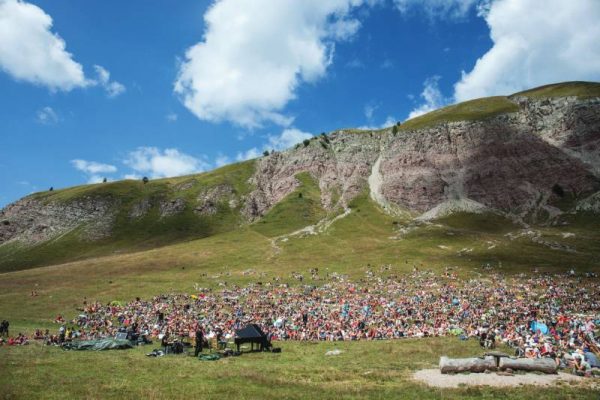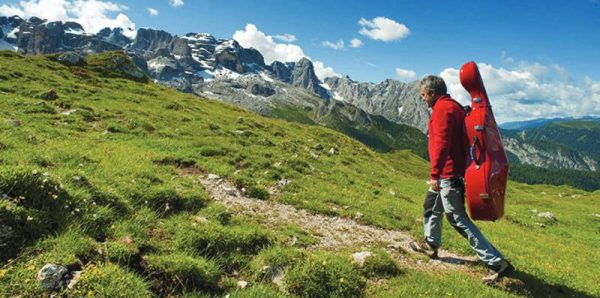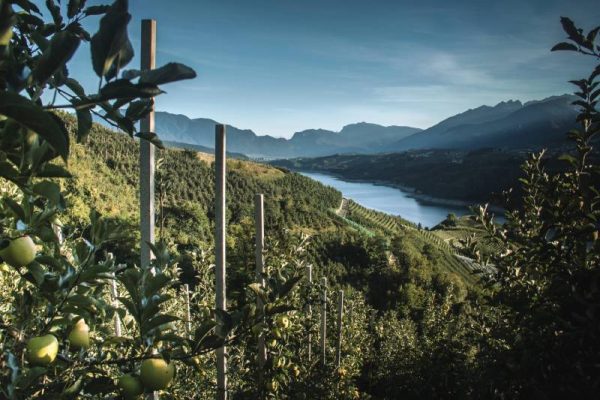Sarah Rodrigues enjoys outdoor opera in the soaring Dolomites, where the dress code is hiking boots and walking gear.
Hiking up a mountain is definitely not for everyone, but even the most reluctant of up-hillers (and there are a few of them around me, if the heavy panting and ragged gasping I can hear is anything to go by) would probably concede that the view from the top almost always makes all the exertion worthwhile.
The rewards are all that and more as we approach the end of our hike in the Pian della Nana. We are at 2,090m, in a natural amphitheatre shaped millions of years ago by receding glaciers. And, out of breath though we hikers may be, the same cannot be said of the opera singers, whose soaring voices are carried on the pure mountain air and held within our hearing by the encircling mountains.
Although today’s lowering clouds, pregnant with the threat of rain, seem better suited to a tragedy, the opera we’ve come to watch is the comic Il Barbiere di Siviglia (The Barber of Seville), one of the performances of the Sounds of the Dolomites festival. Held annually from June until August since 1996, the festival sees the hills – quite literally – come alive with the music of open-air performances; not only of opera, but also jazz and classical, all against that spectacular backdrop of the Dolomites.
NOVEL CONCEPT
It’s a novel concept – the idea that you can don hiking boots and layers, rather than evening wear, to go and experience world-class performance, but it’s one that opens up the universal language of music to a much broader audience than that constrained by conventional venues and dress code can ever hope to. Fitness levels aren’t necessarily a preclusion to enjoyment, either: although the hike we’ve embarked on today has involved some elevation, the trail is well maintained and accessible to disabled people and even children; with performance time scheduled for the afternoon, it gives slower walkers the option to take their time over the hike (all the better to stop and admire the views). For people in search of more stimulation, some of the performances take place at the end of more challenging trails – and as for refuelling, most of the programme’s events are held near Alpine huts, where typical mountain dishes are prepared en masse to feed hungry spectators before they make their way back downhill after they have enjoyed the performance.
Image: Mario Brunello carrying his cello up the mountain
There’s a wonderful freedom about the whole experience that goes far beyond the style of clothing we are wearing
Looking around, it seems many people have bought picnics to enjoy during the opera. Some are obviously old hands at outdoor performance, with large throws on which to lounge – or alternatively, to bundle up in when the glow of exertion is replaced by the chill of inactivity. Some lounge on cushions, or low chairs; more than once, I observe people in supine positions, scarves or jackets laid over their faces, just allowing the beauty of the acoustics to wash over them. When children fret, they are simply picked up and taken away to a slight distance. There’s a wonderful freedom about the whole experience that goes far beyond the style of clothing we are wearing; one that is enhanced by the wild beauty of the setting.
ANIMATED PERFORMANCES
Although sung in Italian, the opera we’re watching today would have us in frequent fits of laughter even if we weren’t familiar with the story, so animated are the performers in their reprisals. It’s impressive, too, to observe the level of inventiveness at play when there is no backstage to take advantage of for costume changes, and no curtains or lighting behind which to seek refuge or with which to alter mood: even if the vocals were not fabulous (they are), the production and stage direction would merit a five-star rating.
Not to mention the stage itself, a vast bowl of grass and rock encircled by peaks. On the walk up this geologically carved theatre this morning, glacial striations in the rockfaces had formed an epic setting, looming above undulating grass on which cows, adorned with melodically clanging bells, carelessly grazed, trailing long strings of saliva when they raised their heads to gaze at us incuriously. Now, occasionally, we hear the gentle chime of their music as they wander in these vast surroundings, sounding really rather as though they’d like to get involved in the performance themselves.
Opera had been absent from our walk the previous day, but the cows had still been present, their huge eyes rolling as though exasperated by our presence. We’d started out early from our agriturismo in Val di Sole to reach Val di Rabbi in Stelvio National Park.
Met by a guide, whose enviably careless approach to inclines, steps and heights made him seem more goat than man (and indeed, with his curly hair and wiry physique, there was in fact something quite Pan-like about him) we had made our way through densely wooded trails along the banks of rushing streams – a contrast to the broad, open spaces of Pian della Nana.
The forest floor is thickly covered with ferns, and angled beams of sunlight filter through the conifer forest. Through the occasional clearing, we see chalets watched over by mountains. Beside us, water plays swiftly and merrily over rocks; in other parts of the Val di Sole, white-water rafting is a popular pastime, but here the water is perfect for paddling – well, for a moment, in any case, before its melt-off chill bites our bare feet to dizzying redness.
It’s a mark of how dense the forest is that we hear nothing of the Ragaiolo waterfall until we’re almost upon it. A narrow but crashing ribbon of water, it flows from a great height and is best seen from the perspective of a 100 metrelong Tibetan-style steel suspension bridge, which sways, gut-lurchingly, at around 60 metres above the river. Constructed in 2015, it’s the perfect vantage point from which to take a photo – although a camera strap is definitely advisable.
Enchantment: it comes in many guises, but purity of landscape, shot through with the beauty of artistry and talent, this is surely spell-weaving stuff
NATURAL POWER
The surrounding trees, while being excellent sound-absorbers, were traditionally felled for building purposes: we pass an ancient Venetian sawmill, which used the natural power of the flowing water to operate its machinery. Small bridges and railings still demonstrate the usefulness of such fine arboreal specimens, long and straight-trunked as they are. Further down, our feet now returned to normal colour after the shock of wading, we remove our shoes again and walk barefoot in a designated forest-bathing area, the springy grass cool underfoot.
This area is, in fact, renowned for its waterfalls and, after a lunch best described as life-affirming, we set off to find some more. Past more cows, some of which are sitting placidly on the path, allowing themselves to be stroked by hikers, we leave the alpine meadows behind us and climb up through larch trees to encounter both the high and low incarnations of the Saent Waterfalls. Along the way, we observe a handful of people who are tackling the path on their own and, although our Pan-like guide isn’t critically necessary to our ability to find our way along the well-signposted route, his knowledge about the area’s flora and fauna add layers of meaning to our experience. He’s also highly entertaining, springing up on to railings to point out the woodpecker holes made by different varieties of the bird and, when we eventually reach the uppermost fall, slinging himself with dazzling insouciance over the railings and onto the slippery rocks beyond, gesturing casually for us to follow.
Magnificent as the fall is from a distance, there’s no sensation quite as grand as having your own yelps of glee drowned by its roar, and your idiotic grin soaked by the endless arcs of spray that fracture into rainbows and dampen your face. The thundering of the fall beats in time with our blood and, through the mist, other hikers, unaccompanied by a guide, are green with envy.
Enchantment: it comes in many guises for many people, but purity of landscape, shot through with the beauty of artistry and talent, this is surely spell-weaving stuff. For those who require more conventional motifs, however, the region is also home to Val di Non, one of Europe’s largest producers of apples. In the springtime, when the gnarled, twisted boughs of the trees that cover the lower reaches of this mountainous region are fluffy with blossom, the scent itself must be enough to transform frogs into princes and ducklings into swans. Essentially a giant orchard, Val di Non is home to a number of varieties, some of which are DOP.
You can sample and buy these, in guises ranging from cider to crisps, at the Melinda Apple Factory, located about a 30-minute drive from Trento; for me, a more alluring way of experiencing the beauty, if not the taste, of those neatly planted rows of trees comes with an uncharacteristic early rising.
I make my way through a sleepy village, past unfeasibly endless boundaries of apple orchards, all set against a backdrop of mountains punctuated by church spires; as I headed down through cooler, wooded areas in which the straight flanks of felled logs were neatly stacked, it was already obvious that some sweaty uphilling was going to be required afterwards.
Unlike the prize that awaited at the uppermost point of my opera hike, the value here was to be met at the base; the memory of it to be relished on the return ascent: Lago San Giuliano, a serene circle of water ringed by mountains and sun-warmed by months of summer. I strike out towards its middle, so different from the glacial freeze in which I paddled the other day and, despite the sun’s increasingly high position when I emerge, it’s as though my body is covered in spangles when I make the lungbusting hike back up.
FIND OUT MORE
www.visittrentino.info
www.valdisole.net
www.visitvaldinon.it
www.isuonidelledolomiti.it



